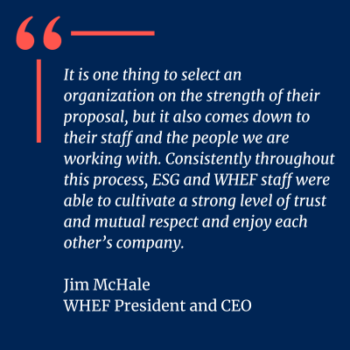Attainment as the North Star: Supporting a Strategic Postsecondary Vision in Mississippi

Since its founding more than 40 years ago, the Woodward Hines Education Foundation (WHEF) has been steadfast in its commitment to transforming postsecondary outcomes for students and families all across Mississippi. Building on its early work as a small startup focused on ensuring the availability of federally-financed student loans statewide, the organization has grown by leaps and bounds in its reach and impact to ultimately elevate Mississippi to a higher degree.
In 2016, WHEF expanded its mission by augmenting its longtime focus on college access – primarily through its college access program, Get2College (G2C) – to add focus on college persistence, college completion, and student entry into careers with family-sustaining wages. And, in 2020, with a new focus on college completion, WHEF helped drive Mississippi’s adoption of a statewide goal, Ascent to 55%, which seeks to raise the postsecondary credential attainment rate of Mississippi’s working-age population to 55 percent by 2030.
 By 2022, the final year of its first-ever strategic plan, WHEF leadership was proud of its successes to date. It was also united in the belief that continued evolution of the organization’s work was essential to drive even greater impact and continue to meet the diverse needs of Mississippi’s students, especially in the wake of the COVID-19 pandemic. The new strategic plan was to “be evolutionary, not revolutionary” and firmly establish Ascent to 55% as the organization’s “north star” goal.
By 2022, the final year of its first-ever strategic plan, WHEF leadership was proud of its successes to date. It was also united in the belief that continued evolution of the organization’s work was essential to drive even greater impact and continue to meet the diverse needs of Mississippi’s students, especially in the wake of the COVID-19 pandemic. The new strategic plan was to “be evolutionary, not revolutionary” and firmly establish Ascent to 55% as the organization’s “north star” goal.
WHEF selected ESG to serve as its core thought partner and co-architect of a revised strategic plan and theory of change. Between March and December 2022, ESG and WHEF engaged in a comprehensive strategic planning process to shape the organization’s future, culminating in the public release of a new strategic plan in early 2023. The strong partnership between ESG and WHEF, which continues today, has developed organically over time, but it is grounded in two foundational elements.
Shared Core Values: Equity
In the poorest state in the nation, with one of the highest Black populations, WHEF understands that racial equity has to be at the heart of what they do; the data are clear that students of color are disproportionately behind in terms of postsecondary attainment in Mississippi, and intentional support for students of color is necessary to eliminate outcome gaps across the state. According to Jim McHale, WHEF’s President and CEO, “WHEF has realized that in order to have the greatest impact, we must put a flag down for those who don’t have a voice in our state.”
Similarly, ESG has made increasing postsecondary attainment in pursuit of expanded economic mobility its north star, with a specific emphasis on increasing attainment rates for students of color and from low-income backgrounds. The aligned values and core focus of both organizations, combined with a shared commitment to fully understand and appreciate Mississippi’s context, set the stage for a successful partnership and strategic planning process.
Shared Commitment: Elevating Student and Community Voice
The strategic planning process began with ESG creating tailored experiences for WHEF staff to reflect on the prior five years, name their successes, and identify areas for growth and improvement. This process allowed WHEF team members to be both vulnerable and constructive, building on the successes of the past while honing a vision for even greater impact in the future.
As WHEF President and CEO Jim McHale reflected, “from early on, as we do quite regularly, we were able to remind ourselves about what our founders wanted, and how we need to care for those priorities in modern contextual ways to allow us to meet the needs of students today. In this process, ESG was equally committed to understanding the local history and context of both WHEF and Mississippi.”
Through this work, ESG engaged every WHEF staff and board member, along with stakeholders across the state to understand their perspectives on WHEF’s work to date and their hopes and dreams for its future. This process included gathering insights from parents, educators, students, state leaders, agency heads, school districts, higher ed institutions, workforce leaders, community-based organizations, other foundations, and elected officials. It spanned a wide range of sectors and geographies, including Jackson, Ocean Springs, Southaven, and towns all across the Mississippi Delta. All told, ESG facilitated more than 50 conversations with hundreds of individuals, from the boardroom to the classroom, from the schoolhouse to the statehouse.
The Path Forward
Following the February 2023 release of WHEF’s 2023-2028 Strategic Plan, ESG and WHEF launched a second phase of their partnership. This implementation-focused phase of the work focused on the development and refinement of a menu of services for Get2College’s outreach arm, aligned directly with WHEF’s new strategic plan. Through this work, ESG has helped WHEF and G2C optimize the balance between direct service provision and capacity building in order to maximize the organization’s impact on Ascent to 55%, its north star goal. As a result, G2C has a plan and framework to serve more students, while offering even deeper and more intentional support to equitably serve students and schools with the greatest need. Underlying this approach is a school prioritization framework that assesses need quantitatively, while supplementing this picture with more qualitative and contextual indicators of school readiness.
WHEF will continue to refine and adapt its G2C outreach strategy to remain attentive to the needs and realities of their partners on the ground, while also staying laser-focused on Ascent to 55%. While there is much work to be done to enhance postsecondary attainment in Mississippi and across the nation, the Magnolia State is fortunate to be supported by a visionary leader like the Woodward Hines Education Foundation. ESG is excited to witness the next generation of WHEF’s work in Elevating Mississippi to a Higher Degree.



